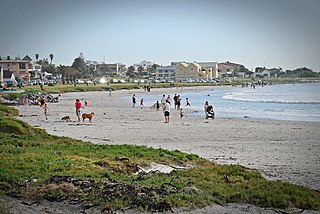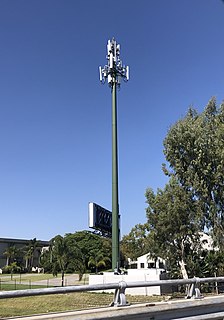SAT-2 was a submarine communications cable linking Melkbosstrand, South Africa, to El Medano, Tenerife Island, Spain and Funchal, Madeira islands, Portugal. It was 9,500 kilometres (5,900 mi) long, contained 82 repeaters, operated at 560 Mbit/s and was in service from 1993 to January, 2013. It is the property of Telkom SA Ltd, Telefónica, Marconi, British Telecom, France Cables et Radio, and Deutsche Telekom.

ATLANTIS-2 is a fiber optic transatlantic telecommunications cable connecting Argentina, Brazil, Senegal, Cape Verde, Spain's Canary Islands and Portugal. It is the first submarine cable to link South America and the African continent.
SAT-3/WASC or South Atlantic 3/West Africa Submarine Cable is a submarine communications cable linking Portugal and Spain to South Africa, with connections to several West African countries along the route. It forms part of the SAT-3/WASC/SAFE cable system, where the SAFE cable links South Africa to Asia. The SAT-3/WASC/SAFE system provides a path between Asia and Europe for telecommunications traffic that is an alternative to the cable routes that pass through the Middle East, such as SEA-ME-WE 3 and FLAG. SAT-3 has a capacity of 340 Gbit/s while SAFE has a capacity of 440 Gbit/s. The SAT-3 system together with SAFE was built by a consortium of operators. As of 2006, major investors included Telkom Group, France Telecom (12.08%), Nitel (8.39%); TCI, a subsidiary of AT&T Inc. (12.42%); and VSNL (8.93%).
The Eastern Africa Submarine Cable System (EASSy) is an undersea fibre optic cable system connecting countries in Eastern Africa to the rest of the world.
Mtunzini is a small coastal town that is situated almost exactly halfway along KwaZulu-Natal's coastline in South Africa approximately 140 km north of Durban. In 2011, the town's population was 2,199.
SEA-ME-WE3 or South-East Asia - Middle East - Western Europe 3 is an optical submarine telecommunications cable linking those regions and is the longest in the world. Completed in late 2000, it is led by France Telecom and China Telecom, and is administered by Singtel, a telecommunications operator owned by the Government of Singapore. The Consortium is formed by 92 other investors from the telecom industry. It was commissioned in March 2000.

South East Asia–Middle East–Western Europe 4 is an optical fibre submarine communications cable system that carries telecommunications between Singapore, Malaysia, Thailand, Bangladesh, India, Sri Lanka, Pakistan, United Arab Emirates, Saudi Arabia, Sudan, Egypt, Italy, Tunisia, Algeria and France. It is intended to be a complement to, rather than a replacement for, the SEA-ME-WE 3 cable.

Melkbosstrand is a coastal town located on the South West Coast of South Africa, 30 km north of Cape Town. It forms part of the City of Cape Town Metropolitan Municipality, the municipality governing Cape Town and its greater metropolitan area.

The Internet in South Africa, one of the most technologically resourced countries on the African continent, is expanding. The Internet country code top-level domain (ccTLD) .za is managed and regulated by the .za Domain Name Authority (.ZADNA) and was granted to South Africa by the Internet Corporation for Assigned Names and Numbers (ICANN) in 1990. Over 60% of Internet traffic generated on the African continent originates from South Africa. As of July 2016, 29.3 million people were Internet users.
TEAMS is an initiative spearheaded by the government of Kenya to link the country to the rest of the world through a submarine fibre optic cable. It was first proposed as an alternative to EASSy, the East African Submarine Cable System. The Kenyan government had grown frustrated with the ownership model favoured by South Africa, the time it was taking and what it perceived as an attempt by South Africa to control the cable. As a result, in November 2006, the Kenyan government decided to partner with the Emirates Telecommunication Establishment (Etisalat) to build its own fibre optic cable.
The Main One Cable is a submarine communications cable stretching from Portugal to South Africa with landings along the route in various west African countries. On April 28, 2008, it was announced that Main Street Technologies has awarded a turnkey supply contract for the Main One Cable System to Tyco Telecommunications.

The West Africa Cable System (WACS) is a submarine communications cable linking South Africa with the United Kingdom along the west coast of Africa that was constructed by Alcatel-Lucent. The cable consists of four fibre pairs and is 14,530 km in length, linking from Yzerfontein in the Western Cape of South Africa to London in the United Kingdom. It has 14 landing points, 12 along the western coast of Africa and 2 in Europe completed on land by a cable termination station in London. The total cost for the cable system is $650 million. WACS was originally known as the Africa West Coast Cable (AWCC) and was planned to branch to South America but this was dropped and the system eventually became the West African Cable System.

Africa Coast to Europe (ACE) is an optical-fiber submarine cable system serving 24 countries on the Europe, west coast and south Africa, managed by a consortium of 20 members.
SAex is a proposed submarine communications cable linking South Africa to the United States with branches to Namibia, Saint Helena, and Brazil.
The CS Chamarel, originally CS Vercors was a cable layer owned by France Telecom Marine, laying submarine communications cables around the world. It was built in 1974 and destroyed by a fire in August 2012. As the Vercors, the ship laid cables on and between all continents except Antarctica, including numerous trans-Atlantic cables and the first ever Israeli-made cable, and set the record for the deepest submarine buried cable lay in 2000. The ship was badly damaged by a fire and driven aground on 8 August 2012.
The South Atlantic Cable System or SACS, is a submarine communications cable in the South Atlantic Ocean linking Luanda, Angola with Fortaleza, Brazil with a leg connecting the Brazilian archipelago of Fernando de Noronha as well. It is the first low latency routing between Africa and South America.

WASACE was a planned system of submarine communications cables consisting of four sections with a total length of 29,000 km linking four continents.

The Bay of Bengal Gateway (BBG) is a submarine communications cable providing a direct trunk connection between Barka and Penang (Malaysia) with four branches to Fujairah (UAE), Mumbai (India), Colombo and Chennai (India). The project was carried out by a consortium that includes Vodafone, Omantel, Etisalat, AT&T, China Telecom, Telstra, Reliance Jio Infocomm, Dialog and Telekom Malaysia. Construction was started in May 2013 and was completed by the end of 2014. From Penang the system is connected via a terrestrial connection to Singapore. The length of the submarine Cable system is 5,934 km from Barka to Penang, with a 216 km branch to Fujairah, 426 km branch to Mumbai, 142 km branch to Colombo and a 1,322 km branch to Chennai, totaling a total length of 8,040 km.

South East Asia–Middle East–Western Europe 5 is an optical fibre submarine communications cable system that carries telecommunications between Singapore and France. The cable is approximately 20,000 kilometres long and provides broadband communications with a design capacity of 24 terabits per second between South East Asia, the South Asia, the Middle East and Europe.









